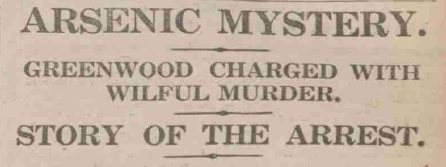The mysterious poisoning of Mabel Greenwood
Arsenic was a poison in common circulation in the 1920s and could easily be obtained in chemist shops. The only requirement was for you to sign the poisons register so there would be a record of the purchase.
Arsenic was used to make weedkiller, rat poison, and found in inks of printed wallpapers, clothing, food colouring and beauty products. As a tasteless and odourless white powder, it dissolves easily in hot fluids such as tea or cocoa. One of the symptoms of arsenic poisoning is diarrhoea leading to dehydration.
In Agatha Christie’s first novel, The Mysterious Affair at Styles, published in 1920, she famously wrote, “poison is a woman’s weapon”. See my post: Favourite Poisons in 1920s Crime Fiction.
However, there were several court cases at this time that accused men of employing poison as a weapon. One of the most famous trials was of Harold Greenwood, a solicitor charged with murdering his wife by arsenic poisoning.
Harold and Mabel Greenwood and their four children moved to Kidwelly in Carmarthenshire, Wales in 1898. Harold’s work as a solicitor provided an irregular income while his wife received payments from the estate she’d inherited from her father, and the family were able to live comfortably.
On 15 June 1919, Mabel Greenwood complained of stomach pains after eating a gooseberry pie at lunch. Her husband gave her brandy, which caused her to vomit. Between 6.30 to 7pm, she became very unwell, and with difficulty, her husband and daughter took her upstairs to her bedroom. Mabel was in pain, vomiting, and had diarrhoea.
A Dr Griffiths was called, and he gave Mabel some medication. But by the early hours of 16 June, she had died. The cause of death was certified by Dr Griffiths as heart disease.

Mabel Greenwood
Four months after his wife’s funeral, 45-year-old Harold married for a second time. His new wife, Gladys Jones, was in her 30s. This age difference caused much gossip in the local community.
While Mabel Greenwood had been popular and active in Kidwelly, the town were not as keen on her husband. A male acquaintance described him as ‘not having a single man friend and being fond of stirring up mischief and trouble. On the other hand, he was exceedingly popular with the opposite sex’.
Gossip increased to such a level that in October 1919, the police exhumed Mabel’s body for forensic examination. Her remains showed no evidence of heart disease, but her body did contain 0.25 to 0.5 grains (16 to 32 mg) of arsenic.
An inquest was held in June 1920, and the jury was told Harold had purchased weedkiller containing arsenic. They returned a unanimous verdict of ‘murder by arsenical poisoning ... administered by Harold Greenwood’.

Harold was arrested on 17 June 1920, and his trial began on 2 November 1920. The defence argued that Dr Griffiths had given Mabel medication (bismuth and morphine), which could be a cause of death independently of any arsenic. Dr Griffiths changed his story, later saying it was not morphine but opium, then a much weaker drug, and the defence played on this.
The defence also showed that the evidence of Hannah Williams, the Greenwood’s maid, had been strongly influenced by a police officer who'd interviewed her some time after the death and that she’d changed her story on several occasions.
Harold Greenwood stood as a witness in his own defence and endured lengthy cross-examination. He denied any involvement in his wife's death.

The prosecution’s case began to fall apart when it was revealed that Mabel Greenwood’s money would not pass to her husband on her death but go to her children. Mabel hadn’t left a will, but her father had stated in his that the money was hers for life and would pass to her children in equal shares on her death.
Harold did not gain financially from his wife’s death. However, it had allowed him to marry again.
But the prosecution case was irrevocably damaged by the evidence of Irene Greenwood, Harold and Mabel’s 22-year-old daughter. Irene stated she’d drunk from the wine bottle alleged by the prosecution to have been the source of the poison that killed Mabel and suffered no ill effects.
In his summing up, the judge said, "If she also drank from the bottle, there is an end of the case".
Harold Greenwood was acquitted. However, the jury added a rider to their verdict that was not published at the time, saying, "We are satisfied ... that a dangerous dose of arsenic was administered to Mabel Greenwood ... but we are not satisfied that this was the immediate cause of death ... (nor) how or by whom the arsenic was administered".
The verdict did nothing to improve Harold's popularity in Kidwelly, and he and his second wife moved to Ross-on-Wye, Herefordshire, where he changed his name to Pilkington. But his health deteriorated, and he died in 1929, nine years after the trial.

